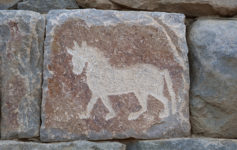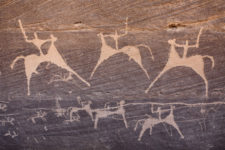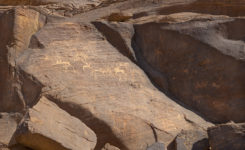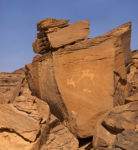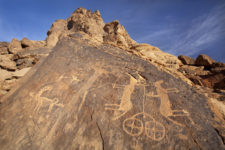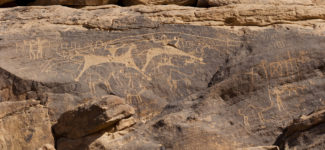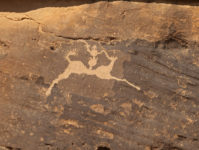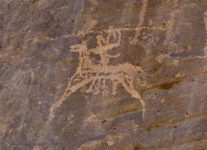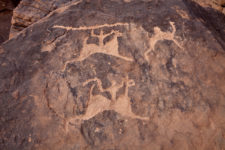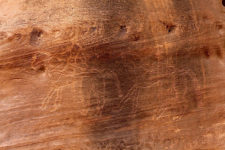There is much debate about when the horse arrived in the Arabian Peninsula and from which direction. Because petroglyphs are difficult to date directly, we must rely to a large extent on style and how the horses are depicted to arrive at an estimated age.
The earliest images of horses are associated with chariots, although only one chariot is depicted at a time, instead of numerous ones in battle. The earliest chariot depictions, of which there are now several known in the north, are depicted in a style reminiscent of one found across Central Asia. They are not associated with any early Arabic script and most likely date to the Bronze Age, second millennium BCE. These simple, deeply incised vehicles are shown pulled by two horses, lying in a recumbent pose back to back. The four-spoked wheels of the vehicle are shown lying flat, as well. The horses are generic in appearance, with no clearly defined Arabian traits. The close similarity between Central Asian depictions and these found in Saudi Arabia may indicate the direction from which horses and chariots or knowledge of them, at least, entered the Arabian Peninsula.
Chariots that are most likely from a later period are shown in profile, similar to depictions of Egyptian, Assyrian, and other classical chariots. They are also only to be found in the north. They are often accompanied by Thamudic writing, an early Arabic script, which is known to date at least to the first millennium BCE.
The chariots from this period are pulled by horses that have a number of features in common with the modern Arabian breed. However, the wheels and the chariot box are often rather unrealistically portrayed, leading one to wonder how familiar the artists were with the actual vehicles. Chariots would have been poorly suited for deep sand or rocky surfaces and the materials needed to construct them would not have been plentiful in this region. It is not apparent that chariot warfare ever played a significant role in Saudi history.
It is significant that the later images of chariots are almost certainly proto-Arabian or actually Arabian horses. The features they share in common with that breed include: a concave or straight facial profile, large eyes, powerful arched neck, short back, well-developed chest and hindquarters, lean girth, and high tail dock.
The Arabian horse appears in Egyptian tomb art in Luxor around the time of Thutmose IV (1401-1391 BCE), if not slightly earlier, and in association with the chariot. His grandfather, Thutmose III (1479-1425 BCE) brought thousands of horses back from his campaigns in the Levant, which could be the Egyptians’ source for Arabians. It is possible that some of the Arabian horses in Saudi rock art could date back as early as the time of Thutmose III or IV, so perhaps around 1400 BCE. Those associated with Thamudic script may be somewhat later, around 1000 BCE.
Riding is much more prevalent than chariotry as a subject in Saudi petroglyphs. Horses become gradually more available and widespread through time, as cavalries overcame chariots in warfare. Certainly, riding was a far superior means of transportation in the Arabian terrain. The oldest examples of riding show the absence of stirrups quite clearly, with fully-extended legs on the rider. Most of the horses from any time period are shown being ridden bareback, although saddle blankets are known from several examples. Bridles, leads, and riding crops are shown occasionally.
Later images of battle scenes in the Bir Hima region of Najran Province depict cavalrymen with legs tucked up, presumably indicating the use of stirrups. Most of these seem to date to the first millennium CE. These mounted warriors were wielding weapons that would have been used more effectively with stirrups, such as swords, sabers, and extremely long lances. At the site of A’abar Harema, some horses have dots placed just outside their bodies all the way around. These may have symbolized scalar armor, because it is hard to imagine what else they might signify. The images like those on the “Painted Bull” panel are shown in a style that is unique to this southern region. Because the horses are very stylized, it is not definitive that they are of the Arabian breed, but their high tail carriage and slender girth hints that that is the case.

























